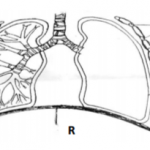KNEC KCSE Biology Paper 1 – 2014 Cross Country Mock
2014 Cross Country Mock
Biology Paper 1
Rewrite the correct form of the scientific name for the African elephant Loxodonta
Africana.
1 marks
A potato cylinder measuring 100mm was placed in a concentrated salt solution for 30
minutes. Describe its texture and appearance after 30 minutes.
3 marks
(a) State one adaptation of palisade cell to its function (1mark)
(b) State the products of photolysis (2marks)
3 marks
What is the function of carnassial teeth.
1 marks
The structure below is a centriole found in animal cells only.
State its functions in animal cells.
i) ………………………………………………………………………………………
ii)………………………………………………………………………………………
2 marks
(a) People can die when they inhale gases from burning charcoal in poorly ventilated
rooms. What compound is formed in the human body that leads to such deaths (1 mark)
(b) Most carbon (IV) oxide is transported from tissues to the lungs within the red blood
cells and not in the blood plasma. Give an advantage of this mode of transport. (1 mark)
2 marks
Study the diagram below and answer the questions that follow
(a) Identify the diagram above (1mark)
(b) State one reason for your answer in (a) above (1mark)
(c) Name the parts labeled A, B and D (3marks)
(d) State the function of the part labeled C (1mark)
6 marks
(a) State two disadvantages of fossil records as an evidence of evolution (2marks)
(b) What is adaptive radiation (1mark)
3 marks
(a) Which vitamin is synthesized by bacteria in the human colon (1mark)
(b) State the function of the vitamin named in (a) above (1 mark)
2 marks
Name the structure in plants involved in the following functions.
(a) Absorption of water
(b) Transport of water
(c)Translocation of food
3 marks
Study the food chain below and answer the questions that follow
Green plants Insects Lizards Eagles Snakes
(a)Name the trophic level occupied by the
- Green plants (1mark)
- Eagles (1mark)
(b)Explain why energy from green plants to insects is more than that from lizards to snakes
(2marks)
4 marks
(a) With a reason name the structure responsible for intermittent growth in an insect
Structure ……………………………………………………………………………………………………………… (1mark)
Reason ……………………………………………………………………… …………………………………………(1 mark)
(b) What is the hormone responsible for growth in an insect (1mark)
3 marks
(a) What is reversed stomatal rhythm in xerophytes (1mark)
(b) How can this phenomenon in (a) above be a limitation to the plant in terms of gaseous
exchange (1mark)
2 marks
(a) A dog weighing 15.2kg requires 216kJ while a mouse weighing 50g requires 2736KJ per day.
Explain (2marks)
(b)What is the end product of respiration in animals when there is insufficient oxygen supply
(1 mark)
3 marks
The figure below is a structural diagram of a portion from a nucleic acid strand
(a) Giving a reason, name the nucleic acid to which the portion belongs (2 marks)
Name
………………………………………………………………………………………………………………………………..
Reason
…………………………………………………………………………………………………………………………………
(b) Write down the sequence of bases of a complimentary strand to that shown above (1 mark)
3 marks
The figure below shows a stem of a plant growing round a tree trunk
(i) What is the name of the response which causes the twisted growth (1 mark)
(ii) Explain how the twisting process is accomplished (2 marks)
3 marks
Below is a diagram of an organism
(i) State the class which the organism belongs to (1 mark)
(ii) State two observable characteristics used to classify the organism in the class you have
mentioned in (i) above (2 marks)
3 marks
State two examples of mutagens.
2 marks
Study the diagram below and answer the questions that follow
(a) Name the principle labeled X (1mark)
(b) If the above diagram represented blood sugar regulation
(i) State the corrective mechanisms carried out at A (2marks)
(ii) The condition that may result from the further excess (1mark)
(iii) The hormone that would be responsible for correcting the deficiency (1mark)
5 marks
Name the main sites of gaseous exchange in:
(i) Mammals
(ii) Leaves
(iii) Amoeba
3 marks
Below is a diagram illustrated for an animal tissue
(a) What is the identity of the illustrated diagram (1mark)
(b) Where in the human body can the illustrated be found (1 mark)
(c) What makes it very efficient for its function of impulse transmission (1 mark)
3 marks
(a) Name the three strengthening tissues in plants (3 marks)
(b) State two ways in which the xylem is adapted to its function (2marks)
5 marks
A leguminous plant uprooted showed some feature on its roots as shown below
(i) State the identity of Z (1 mark)
(ii) Name the bacteria in Z (1 mark)
(iii) Name the relationship between the named bacteria and the root at Z (1 mark)
(iv) What mineral element is availed by the bacteria in Z to the plant (1 mark)
(v) Name one organism that reduces the element named in (iv) above reducing its availability to
plants (1mark)
5 marks
Study the reproductive structure below
(a) Name the parts labeled P and Q (2marks)
(b) State the function of the part labeled R (1mark)
(c) How do the following factors hinder self pollination in plants
(i) Protandry (1mark)
(ii) Self sterility (1mark)
5 marks
State two functions of the enzyme thrombokinase in blood clotting process.
2 marks
Below is a diagram of an organism
(a) What is the identity of the organism (1mark)
(b) Into which kingdom does the organism belong (1mark)
(c) Other than the locomotive structure shown by the above organism name two other
locomotive structures used by other members of the above named kingdom (2marks)
4 marks







